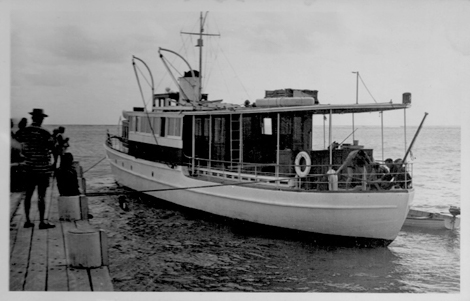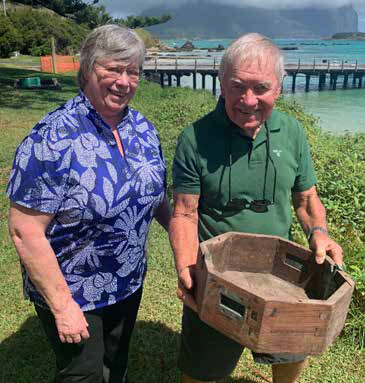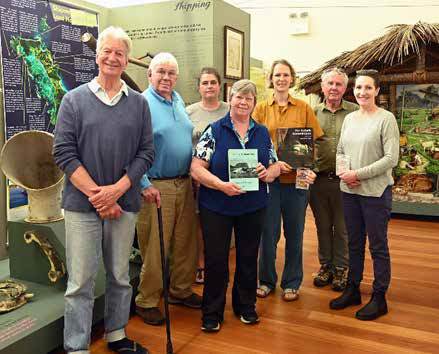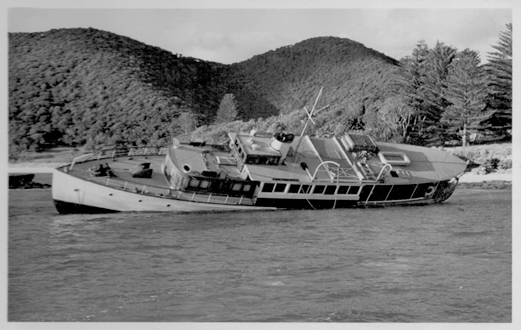In Spanish, Reposado means ‘calm or peaceful rest’, but being shipwrecked could hardly be described as a ‘peaceful’ event.
On Tuesday 24th January, 1961, the 30 metre luxury motor cruiser, Reposado, reversed alongside the Island jetty to recharge its water tanks. At the time a fresh south westerly wind was blowing so, to secure the vessel against the jetty, a bowline was attached to a jetty bollard. However, the line snapped and the vessel drifted helplessly towards the rock shelf on the north side of the jetty. The Reposado’s motors were gunned to try to propel it into deeper water, but this only served to wedged it more firmly (and irretrievably) on the rocks. The vessel was eventually broken up by Island resident, Ray Skeggs, who purchased the salvage rights from the insurers. It was an inglorious end to a top-end boat that had begun life as the Taconite, a luxury motor cruiser commissioned by Bill Boeing, the founder of the Boeing Aircraft Company.
Fast forward sixty-two years
Seattle, on the west coast of the USA, is the home of a much-visited aviation museum called “The Red Barn” considered to be the historic birthplace of the Boeing Aircraft Company. In November this year, one of the early supporters of preserving “The Red Barn”, Donna Thorson (and husband Thor), flew some 13,000km from Seattle to Lord Howe to fully investigate the final resting place of the Reposado. Although ownership of the vessel had changed a number of times since its early days (as detailed by Donna in her article in July’s Signal) it had none-the-less played an extraordinary role in the founding of the Boeing Aircraft Company.

In two meetings at the Island Museum (18th & 19thNovember), Donna explained the vessel’s role in shifting Bill Boeing’s interests from timber milling and iron ore mining into aircraft manufacture. She also met Island residents who could clearly recall the day the Reposado ran aground; and, significantly, all of whom remembered multiple warnings being given to the skipper, Ron Ray, that the vessel should not berth at the jetty owing to its size and deep draft.

Donna explained: “The yacht you call Reposado I know as Taconite. She was built in 1910 for Bill Boeing. Before he got into aircraft, he was making a lot of money in timber and in taconite mining (which is an iron ore), and he decided to have a boat built that would take him up the west coast, the wild coast of Alaska. There was a boat builder in Seattle who had been the first to figure out how to build a wooden boat that could be frozen into the Arctic ice and survive (incredibly strong boats!). He was half-way through building the original Taconite boat for Bill Boeing and the boatyard went bankrupt. So, Bill Boeing had no choice but to buy the yard to get his boat finished. As he was looking at all these guys working on his boat, and getting it finished, he realised they had everything that was needed, in terms of skills and equipment, to build float planes. So when the Taconite was finished he converted the ship yard into building float planes – that became Boeing Plant 1 and was called the Red Barn.
In 1982 or 3 they were trying to save the Red Barn for heritage, for the Boeing Aircraft Company, and they came through with a bunch of flyers about how employees could donate to help save the Red Barn. The people who donated were called ‘Barn Stormers’. I’m one of the early contributors toward saving the Red Barn. When I went out into the shop floor, we still had a bunch of guys from the very old days at Boeing. They were very excited about this fund raising to save the Red Barn and they were busy telling stories, carrying on and all kind of things. When they talked about how we needed to save the Boeing Museum with the rank and file, it was about Bill Boeing not the Company Boeing. They were wanting to save the Red Barn for Bill Boeing. So, we were trundling along with that, and we managed to do it – I’ve brought a book to donate to the museum about the museum funding and how it was brought through.
Then this last Christmas a friend gave me a book which was more of a personal history of Bill Boeing and it talked about Taconite. Well, everyone thinks of the 1930 boat, Taconite, which was a 130 foot boat, and it caught me off-guard. I thought, “Well, wait a minute, what happened to the original Taconite?” So I started chasing her down and I followed her all the way across the South Pacific. The last word I could find was a little ad in a Sydney newspaper, suggesting that by this time she was known as Reposado. It said she was being sold for salvage on Lord Howe Island. And I thought, “Oh, darn!” Because when I found out she’d made it to Sydney, I was thrilled because she might still be alive.

So I sent a note over here and this guy pops up and asked did anyone know what happened to the boat because there was actually a move afoot, if she was still ‘alive’, to try and bring her back to the museum. But obviously that is not going to work. So actually what I know as Taconite, and you know as Reposado, was the founding of the Boeing Company.”
At two Museum meetings, details about the fate of the Reposado were provided by Clive Wilson, Larry Wilson and Jim Fitzgerald, while Caitlin Woods from the Lord Howe Marine Park Office explained why it was not yet classified as an ‘historic shipwreck’. It turns out, in New South Wales, that shipwrecks need to be at least 75 years old before they can be registered as ‘historic wrecks’…whoa, the Reposado foundered a mere 62 years ago!
At the conclusion of the Museum meetings, Donna presented Anna Thompson and the Lord Howe Museum with the book For Future Generations about the Red Barn Museum in Seattle. The Flying Boat Days by Peter Phillipps, about historic flying boat aviation at Lord Howe Island, was then presented to the Red Barn Museum by newly elected Museum Committee member, Kellie Ellis; and Meredith Dunford presented a personal copy of the book to Donna and husband, Thor. Donna is still hoping to locate enough timber from the Reposado to have a model made of the ship that ultimately launched 10,000 planes…
(Our sincere thanks to Museum Desk volunteers, Rod and Glenys Harding from the Anglican Church on LHI, who transcribed Donna Thorson’s presentation from a digital recording.)


